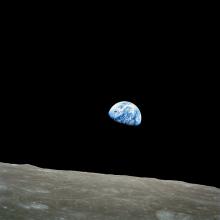Listen to today's episode of StarDate on the web the same day it airs in high-quality streaming audio without any extra ads or announcements. Choose a $8 one-month pass, or listen every day for a year for just $30.
You are here
Moon and Aldebaran
When you watch the Moon move across the sky, you’re actually seeing two separate motions: Earth’s rotation on its axis, and the Moon’s orbital motion around Earth.
The biggest motion is the Moon’s transit from its rising point in the east to its setting point in the west — the result of Earth’s rotation. As our planet spins, everything beyond Earth moves from east to west — the Moon, Sun, stars, and planets.
But the Moon’s other motion, caused by its orbit around Earth, carries the Moon in the opposite direction — eastward against the background of stars. So while the stars all rise about four minutes earlier each day, the Moon rises an average of about 48 minutes later.
This motion is easiest to see when the Moon is near another bright object, as it is tonight — Aldebaran, the orange eye of Taurus, the bull.
Aldebaran will stand to the lower left of the Moon as darkness falls. Over the following hours, though, the Moon will creep ever closer to the star. From Kansas City, for example, they’ll be separated by a bit less than six degrees in early evening — about the width of three fingers at arm’s length. But by the time they set, around 3 a.m., they’ll be just two degrees apart — a difference that’s easily visible to any careful skywatcher.
And if you’re in Alaska, the two will get even closer — the Moon will pass in front of Aldebaran, blocking it from view — a disappearing act caused by the Moon’s orbit around Earth.
Script by Damond Benningfield





